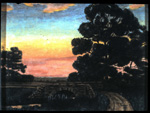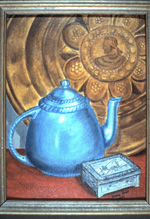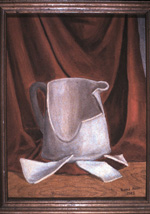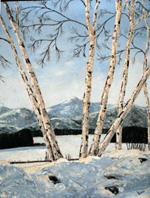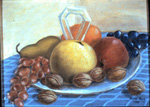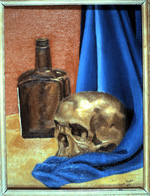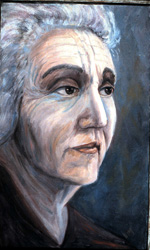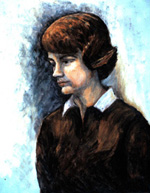Print and Circumstance
by Verna Brady
[Editors note: this book was produced as a follow up to an earlier book "Retrospective Postscript" written for Verna's collectors as a memento after a special set of gatherings where they would bring one of their paintings and each share about it, and she would share her thoughts on painting it. This book is kind of a blend of this earlier book with some elements of the book she later published "My Search of the Real... A Visual Odyssey". The initial chapters which are the same as the earlier book I have provided a link to them, then continued with the additional chapters explaining some of her more recent paintings-at the time of its writing. Judging by the date of the latest paintings included, it would appear to have been written about 1974.]
|
Genesis
"Aren't you ever going back to painting GOOD paintings again---like you USED to?" How can one answer in a few words of casual conversation? . ! . . especially when the inquiry hits a "sore spot" of remembrance of one's own past attitudes and, therefore, cannot be easily shrugged off. .
For. . in my beginnings as an artist, I was very much like those whom I hope to help through this book. My first paintings were done painstakingly in the manner of the old masters; next came landscapes, seascapes, portraits as I gradually progressed through all the varying phases of "realistic painting." Thrilled at being able to peform the CRAFT of painting, I felt sure that those "throwing paint at a canvas" and making such "big messes" just didn't know how to paint! Yet, underneath, there was a gnawing---down deep I knew there was, or had to be, "something" to these wild contemporary techniques---but WHAT? ! I very much wanted to understand and respond to abstract Art but was confused and did not know how. I went to many exhibitions and stood there as perplexed as anyone else, wondering what it was all about.
But, in 1964, my lifelong ambition to become a good artist led me to a summer of Art studies in Paris and brought about my maturation as a painter. The final steps were a knock-down, drag-out struggle under the inspiring guidance of artist-teacher George McNeil, to whom my debt of gratitude is enormous. Yet, as one can only repay his parents for what they have done for him by doing the same for his own children; so, I hope to repay my debt to McNeil by helping others who are seeking an understanding and appreciation of contemporary Art.
An impetus to do this in book form came from people who have bought my paintings. In almost every case, someone newly "attuned" to abstract Art would ask "the meaning behind the painting." The final catalyst was a "retrospective party" in Milwaukee a few years ago. Everyone who owned one of my paintings at the time was invited to come and bring his painting---kind of like a Thanksgiving celebration with all of my "kids" coming back home! Lively discussions about the "stories behind the paintings" punctuated the evening, and eventually I was asked to verify my guests' interpretations or explain my own reasons for the existence of almost every painting. |
When I suggested making a little booklet of write-ups as a memento of the party, the response was enthusiastic; so I undertook what is now incorporated in this volume mainly as Book I....
...Another decided influence was the opportunity, through Mary Thayer, to hang a painting in the main lobby of AC Electronics, Milwaukee (now Delco Electronics). When I was relayed the following overheard remark, "I LIKE it---but what IS it?" a responsive chord resounded within me and set my gears cranking. When Mary responded excitedly to hanging an explantion beside the painting, I worked out the write-up in that frame of mind. Afterwards another overheard comment was, "Now THAT'S what abstract Art needs---NOW I understand it!" . . ! . .
All this happened while I was working on my first attempt at a book, and, so, I decided to use "Prelude" as the final write up in it and had in the back of my mind even then the idea of enlarging the little book to include some of the paintings I had chosed not to sell because of the particularly important and personal reasons for their existence. An enlargement such as this, I felt, would portray even more intimately what abstract Art is all about, and, if people could understand one contemporary artist's work, perhaps they could then begin to understand and better appreciate contemporary Art in general.
In some small way I hope to help some of you to fling wide the doors of your mind to the vastness of the new worlds to conquer in the limitless exploration of our "inner space," for I believe that unimaginable new vistas are only BEGINNING to be expanded in this creative direction. And, if the artist can attune himself to The Infinite and record this adventure, the viewer who is also attuned can respond to the challenge and, through "interiorizing," explore his OWN infinite mind. Is this, perhaps, what young people are so recklessly searching for through drugs?---the ability to experience a closeness to the Infinite? . ! . . For, after all, everyone in this life is on a Quest---everyone is searching for "the Real"---and when a slight glimpse of it is found, the deep surge of fulfillment and happiness is beyond description. And when, somehow, my sensors get short-circuited in the course of painting, I go through such HELL trying to accomplish anything that I'm sure that's what Hell really IS---short-circuited, burned-out sensors unable to tune in to the Infinite! |
The Agony and the Ecstacy
This chapter is about Verna's life-changing experience while taking an art class from George McNeil in Paris. This is included in a more finished form in her book "My Search for the Real...a visual Odyssey." This is kind of a first draft of what is now in the book, but has the basic dramatic experience of her transition to abstract as a result of this class. Her book can be purchased here for this story and many more stories of her self-discovery in art.
~~~~~~~~~~
Only after I returned from Paris and set up, in chronological order, the paintings I had done there, did I realize that this sequence very vividly portrayed my harrowing struggle. For that reason I am including a recollection of the experience in the hopes that MY struggle may help you in yours. |
1.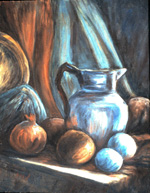 |
2.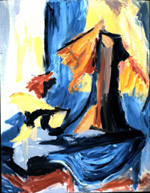 |
3.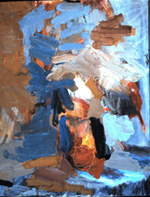 |
In the first two sessions of classes, Dr. McNeil lectured with intensity about a lot of things I'd never understood before---the "push-pull" of colors in space, tensions and---most emphatically, the need to "interiorize." |
The next day he had a lot of still life set-ups and asked that we spend the period painting in our accustomed manner so he could see what we were capable of. (Paris Series 1 above.)
When we walked into class the next time, the set-ups had changed from objects to crumpled pieces of colored paper, bags, bits of cloth---and we were thrown head-long into painting an abstract! He told us that as long as he left an object there, THAT'S what we'd paint--we'd NEVER see the "push-pull," the tensions in space. We were given one period to produce a painting---oh, AGONY! . ! I stood there in dismay---how could anyone make "something" out of THAT mess? . ! . But I was given no choice; so, I floundered . . and knew how terrible it was! (Paris Series #2 above.)
The following day, hallelulia! . . the still lifes were back---safety!---security again! . .maybe I could DO something! . . but alas, not for long! We were told to begin again in whatever way we wished and he would gradually go around the class to help each one see what he was talking about. The set-ups were left intact until he has spent time with each one, and he was so dedicated and intensive that this took quite a few periods. When he got to me, I felt I was practically through and it was pretty good---but no more venturesome that my first. McNeil stood there for a few minutes looking at it and finally said, "You paint very well and have a very personal style." . . oh, joy! Then he picked up the palette knife and scraped off just about all the paint I'd put there! . ! I was shattered! He picked up a brush, started mixing colors, laying them on the canvas and told me THAT was the size it REALLY was, again stressed space, tensions and---"interiorize!" I listened, tried so hard to let it penetrate, but my poor befuddled brain felt his words like heavy rain on a roof---I could hear them but they weren't sinking in! (Paris #3 above.) |
4.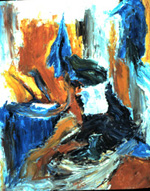 |
5. 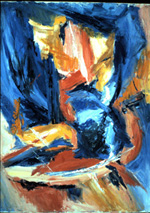 |
6. 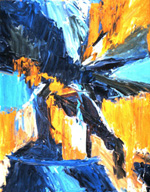 |
The day after McNeil had completed his intial tour of the class we were again greeted by his abstract still lifes and told we'd see nothing else for the remainder of the sessions and he would begin to go around the class again. |
I had already made the decision to accept the challenge and TRY to "interiorize"---try to see in this strange new way and, so, painted with one ear cocked to what he was telling whomever he was with to glean whatever help I could from the overheard lecturing. In canvas #4 (above) I struggled with working with the shapes of the colors before me---a little better than #2 but still pretty lousy!
In canvas #5 (above) I began feeling the swing of the colors but was still floundering.
By #6 (above) I was opening up---I actually COULD see the tension the colors were exerting on each other---the blues were pushing down, pulling up; the oranges were pulling out. . . It was like the roof had suddenly been pried off my mind and the rain clouds were breaking up---I could see some sky! |
7. 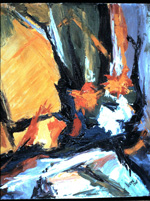 |
8. 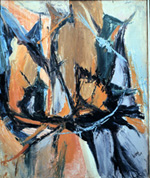 |
In the next two paintings I was so wrapped up in all these new things going on within me that I was oblivious to both McNeil's words and the class. It was during the course of painting #7 (far left) that McNeil got to me again and suggested the quiet area on the left side. He sat and talked with me at length asking if there were places at home where I might exhibit and telling me he had done all he could for me--that I was on my own now and all I had to do was work hard and do a lot of painting . . . Ecstacy! . ! to hear him say what I had felt but not even dared to believe! |
It was later, from a classmate, that I learned that McNeil had been standing behind me for a long time watching what I was doing "with a strange look on his face---like he was trying to figure out HOW you were seeing that." He wasn't the ONLY one! My logical mind surely couldn't have explained either what was going on within me at a much deeper level, but----I had, at last, INTERIORIZED! . ! . !
To fully respond to contemporary Art, you, too, must learn to "interiorize." Practice responding to painting as you do to music. You don't listen to a piece of music expecting it to sound like "something"---in fact, when it does, you don't easily even consider it MUSIC (like some of the experimental contemporary works using taped sounds of traffic, trains, and other noises.) You listen to music with your Soul and respond at a much deeper level than just listening with your ears. Do likewise with paintings Looking ONLY with your eyes requires that the painting look like "something" (a portrait, landscape or still life), but looking with your Soul will bring a response from your subconscious of unprobed dimensions of your being. The oft-heard "I don't know much about Art but I know what I like" attitude is a beginning---but try, also, quiet contemplation and opening up to what you're NOT sure you like, or even what you DON'T like. Strive for a level of response you may not really understand or even be aware that you HAVE.
Very often I have done paintings that I myself do not even understand, but some source within me, which I also do not fully understand, has directed my hand to the final results. . . that, I guess, is what Faith is--believing in the validity of something which your humble human mind is incapable of grasping but knows, somehow, is a fundamental Truth! In paintings like that I may NEVER be able to explain them, but, paradoxically, others seem to respond to them and ASK for no explanations! . . These are the beginnings of the expansion to new dimensions! .

Exodus~My Departures
link to Book One

From Darkness into Light |
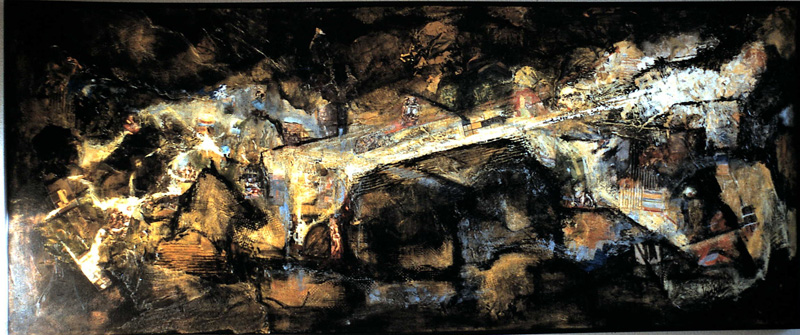 |
Introduction
Because one of my inner promises for a long time has been to try to find methods of awakening others to contemporary Art, my sensors started signaling when I first read Plato's "Cave Allegory" that here, perhaps, was a great possibility: equating this parable to development in modern Art. When I decided to try, I started backwards, so to speak, with the write-up first. My reasoning was that, unless I could successfully interpret the Cave into a sort of "instant Art History" there was no point in doing the painting.
Once I was enough satisfied with a preliminary write-up, I started putting my ideas down in paint. I searched myriad Art magazines for small illustrations of actual paintings, and these are used, but sudued, with other collage materials and paint to develop the journey from traditional to abstract painting. My ultimate ambition at the time was to do it in a large mural-sized series of panels; but you sort of have to have some place to PUT something of that size and so I have not as yet undertaken anything but a small, "trial-size package."
~~~ ~~~ ~~~ ~~~ ~~~ ~~~ ~~~ ~~~ ~~~ |
The Cave Allegory
Plato likened Man's path from Ignorance to Education to a journey from a dark, candlelit Cave up a steep and rocky pathway into the blinding brilliance of Daylight. This some man, exuberant in his new-found Freedom, hurried back to bring the others into the Light, but, in the dimness he stumbled about. . . and could not convince them of the worth of this new Brilliance---after all, had it not "ruined" his eyesight? . ! .
Today an author might use a movie matinee to explain the same concept:
When you are sitting in the blackness of a theater and the movie is flashed on the screen, the images seem very bright and very "real." For those few moments, you "live" what is before you as if it were, indeed, "Truth."
Now suppose you had to leave before the movie ended. As you emerged into the sunlight, your dark-conditioned eyes would be blinded. You would see only brightness--no images.
|
Gradually, of course, your eyes would adjust, and then you would be able to "see" again. If at that point you realized you left something inside and went back to get it, your eyes---now conditioned by the daylight---would no longer see much in the blackness, and the people would wonder why you were stumbling about when THEY could see perfectly well. ! . . .
Do not such parables explain the experience with ANY form of Knowledge? When you emerge from the darkness of ignorance on any subject into the "ight" of Knowledge and Understanting, is it not impossible to go back to that darkness again as if that, indeed, were "Truth?" . . yet, might you not stumble trying to explain your new-found Wisdom? . . .
Once you found the light of True Love, did puppy-love any longer seem "Real?" . . . but who can "explain" Love? . . .
And is not a new concept often considered foolish or worthless. ? . . would a horse-and-buggy driver have believed that his great gradchildren would land on the moon? . ! . . ! . |
A similar phenomena has happened in Art:
Once freed from image-making (reporting) by the camera, Art was able to turn and become enamored with the first light seen . . . Impressionism.
In the process of light adjustment, the structures inside the cave soon became apparent and intriguing. . . Cubism.
Then a brighter light beckoned from ahead, and the steep, difficult climb to reach it was recorded in the experience of Action Painting. . . Abstract Expressionism.
Upon emergence from the Cave, the "eyes" of Art were dazzled by the brilliant Daylight (Freedom) . . . and are still adjusting. . . Abstract, Non-Objective, Op, Lite and all the other modes of contemporary expressionism. . . Yet, . .
When compared with the time Art was shackled in the Cave of image-making (from the first cave drawings to the mid-1860's) . . . nearly 20,000 years!!
the span of time in which Art has been free to search for "Truth" has been very short. . . just over 100 years!!
Is it any wonder that Art is still groping? . . . waiting to "see" the "Real?" . ! . . |
| Ecclestiastes |
Introduction
The biblical book for which this section is named is devoted to the purpose and value of human life on earth.
The following are some excerpts from my "thought books"-- small notebooks I use to jot down my thoughts and ideas from time to time. Most of these begin as "a philisophical thought for the day," . . . oftentimes concerning the purpose and value of Art in relationship to life. Art itself IS a philosophy of life and perhaps should NEED no words---just as a good piece of music NEEDS no lyrics. But, as lyrics can sometimes make the music even MORE meaningful, so perhaps reading some of an artist's thoughts here and elsewhere in this book may make abstract Art more meaningful for you. |
What is "Real?"
So many people still insist
Art must depict the "Real"---
But should one not from that persist---
Is "Real" to SEE or FEEL?
Can simply seeing what's OUTSIDE
With a detach-ed stare
Be half so Real as what's INSIDE---
The "place" you REALLY care?
Is it the same to SEE a fire
As FEEL one when you burn?
Is it the same to SEE a kiss
As GIVE one in return? |
From the Ecclesiates:
"The eye is not satisfied with seeing
nor is the ear filled with hearing." . . .
The artist's eye is never satisfied with JUST seeing. . . . He strives to see the commonly seen UNcommonly. . . and more --- to "see" the commonly UNseen. ! . . .
Art is the expression of the Infinite in man. |
In the course of painting, sometimes the gates of heaven are only a little beyond the gates of hell. ! . .
~~~~
To copy is not to create---to become Art with a capital A painting must go beyond the craft of painting the THING to producing the EFFECT of the "thing."
~~~~
If only I could put on canvas the fantastic visions I "see" in my head. ! . .
~~~~
What size must a painting be to convey a "big" message? . . . The secret of the mighty oak is in the tiny acorn! . . ! |
One of my "fun" poems---written when tempted to enter an abstract in a self-portrait exhibition with these words superimposed on it":
Canvas, canvas on the wall
Are YOU the truest of them all?
For YOU reflect that inner space
As do the eyes upon the face.
Your texture, color, content, line
Are no one's choice but mine.
No FACE need state from off this wall
To tell the world my secrets all! |
Art and Science
The realm of the scientist is to
Explore the infinity of "outer space."
The realm of the artist is to
Explore the realm of "inner space."
And yet their paths entwine:
The scientist explores via
his "inner space" (mind) . . .
The artist explores via
his "outer space" (sight) . . . |
Receptivity---Sensor Analysis
To bring the myriads of waves in the air
Into focus as voices and pictures,
One must plug the TV cord into
An energy source---the electrical outlet---
And turn on the knob. . .
To bring the myriad of paint blobs on a canvas
Into focus as a work of Art,
The artist must plug HIS cord of
infinite mind into
THE Source of life-energy---The Infinite Mind---
And turn on the knob of his sensitivity. ! . |
Art is Experience
To enjoy and love Art (or a work of Art) is
To experience an uplift of the Soul
Akin to the artist's experience in creating it.
Just as the Soul is not happy until it touches the Infinite---
So the artist is not happy until
The Infinite touches his painting. .
For a work of Art must transcend time---which is to say---
It must combine the efforts of the body,
mind
and SOUL
into a new Experience . . . . Yet . .
Experience cannot really be explained by the logical mind. . .
Experience can only be FELT. ! . . Nonetheless,
As Man has always tried to explain HIS particular
Experience of LOVE---
Let me, likewise, try to explain MY particular
Experience of painting. . . |
| |
|
| Book II |
The Sixth Day
The painting began as an experiment in textures and was one of the first using sand as a textural element. It remained completely abstract for a long time, but suddenly the beginnings of a human figure seemed to be emerging from the sand area. At that point I decided to leave it in the suggestive stage and call it "The Sixth Day"--the day on which God created Man out of dust (sand).
But abstracts are an adventure for the artist as well as the observer; oftentimes long after I am through with a painting I see something I had never seen before, and just as often, others show me things I had not seen either---like being told the figure in this painting looks like a polar bear coming down rocks . ! . once pointed out, I could see him too! That's the fun of abstract. The observer's response is not necessarily the same as that which the artist had in mind when painting, for his interpretation is usually from a memory evoked or an experience recalled due to the appeal to his own superconscious of particular lines, colors, shapes or a combination of all three. Most often the MOOD is communicated, but the cause for the mood is ordinarily personal. . . each of us has his own qualifications for what constitutes happiness, gaiety, sadness or any of the other subjective moods we all go through. |
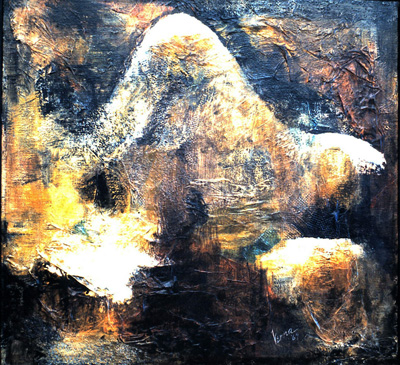 |
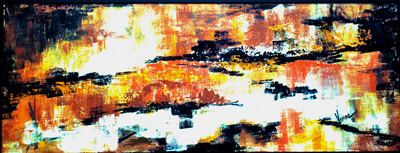 |
Return to Mother Earth
Since the advent of my McNeilesque working methods, I rarely begin a painting with a preconceived notion as to the outcome, for another of the adventures of the abstract for the painter is the confrontation of a blank piece of canvas as some new world to explore. It is also a dilemma as well as a challenge, of course---the whiteness of that canvas seems pretty impenetrable and overpowering---you don't know exactly HOW to conquer it, where to start or what you'll go through before you finish it or IT finishes YOU. ! . .
|
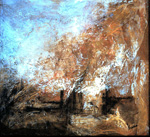 |
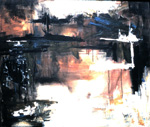 |
Because my response to the beauties of nature is very great and very deep, these feelings are bound to come out now and again in my paintings---just as so often I see figures in spots of grease on a pavement, peeling paint on a wall, rock formations, patterns in linoleum or the abstract lines in one of my paintings---because my response to the beauty of the human body and the worth of the human being is also profound. |
Abstract Figurism
All of these paintings were done in the same manner---working with the colors and lines in my set-ups during a period when I was much in the mood to find figures in the abstract. Yet I wanted to leave them atmospheric---with the background and figure integrated---the colors and lines flowing in and out of the positive and negative space so that only by emphasis of a few areas of the figure (usually the calf, hip and shoulder) would the figure emerge.
The type of figure which develops out of an abstract always seems more alive and dynamic than ones from a sketch or from the model. A model is inhibiting---you put down what you see, and it's pretty hard to pose in a dynamic position long enough for an artist to finish a painting. . . |
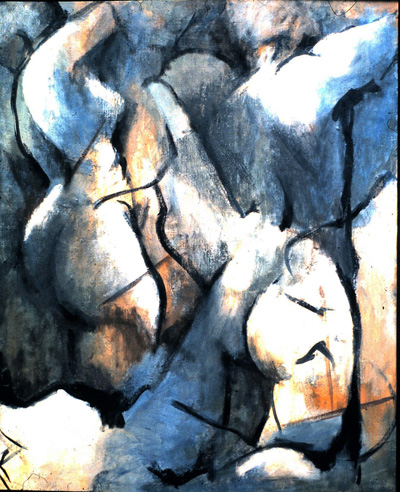 |
In a philospphical mood one day during the days of the [civil rights] demonstrations, I sat looking at some of these paintings and composed the following:
Tis strange indeed to contemplate
How man can look on man with hate
As if the color of his skin
Could TAINT the mind and soul within.
And yet with ease he seems to view
A figure done in ANY hue
And see beyond that surface tone
A human presence like his own. ! . . |
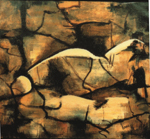 |
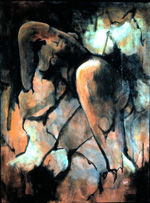 |
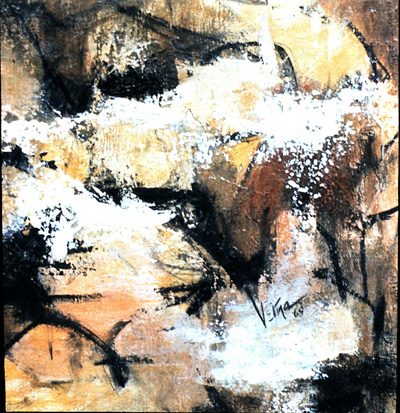 |
Of Many Moods
Most of the time paintings are done for no other reason than the need to paint, and usually these express the mood the artist happens to be in---both positively and negatively. Sometimes a bleak, dreary mood is best gotten out of your system by painting it out (and then coating it with gesso!) and very often the setting down in paint of a particularly happy mood also makes that mood all the more savored.
"Happiness" was done in such a mood, and the short write up expressed my feelings: "True Happiness is a bubbling up from the well-springs of the Soul---as bubbly effervescence here is the surface quality of the depth behind it." |
"Through the Trees" could also be entitled "Homage to Hoffmann" because it was the result of responding to a painting by Hans Hofmann with such excitement and enthusiasm that I rushed home and began painting---and the result is similar, yet different, from the way he painted. He was McNeil's "McNeil" . . small wonder my response ! . ! . . |
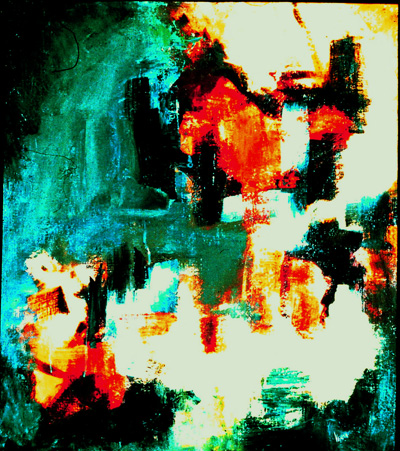 |
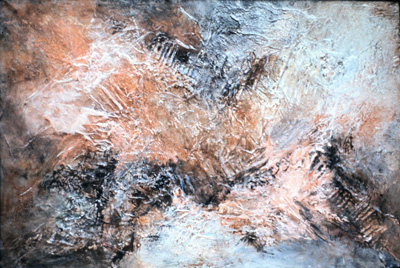
|
Genesis was a quiet mood of working with various textural elements. The result was a feeling of an elemental movement and churning with something about to evolve---hence the title. |
"After the Fall" was produced when I was in a deeply philosophical mood and worked purely from my subconscious. Somehow---I'm not exactly sure WHY---the lines in the painting evoked in me the impression of Christ falling with the Cross. |
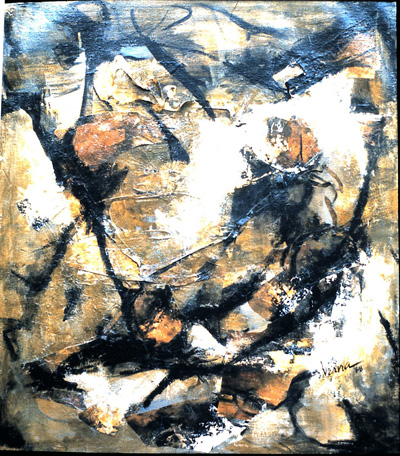 |
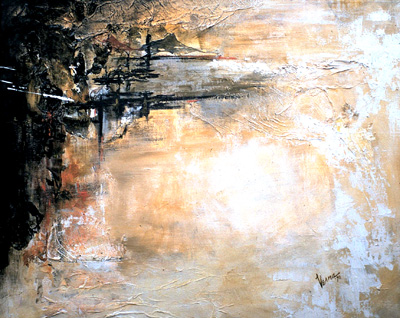
Through the Mist |
Palette Peelings
One time when I was particularly disgusted with a painting and, thus, with myself, I looked down at my palette (a sheet of glass on my taboret) and thought---good grief---THAT looks better than the canvas! ! Which, at the moment, was only my consternation that I couldn't DO anything, but the seed of an idea must have implanted. One day when I particularly liked my "messing around" on the palette, I decided to try to get it off and onto the painting! . !
Since that time I have used this technique in areas on quite a number of canvases because I can obtain effects impossible to get any other way. Ordinarily the result is best if used in a cascade sort of way---it seems to lend a mystery to the painting---perhaps because the actual mixing of the paint is done so unconsciously that it is tapping unknown depths unawares. . .
|
Madonna
In the Advent season of 1968 I was in a mood to do a Madonna and began a painting with this is mind, sketched, painted, wiped out and repainted time and again for over two weeks, and each time I was dissatisfied with the results---either too "icky-sweet" or lifeless! Finally, in exasperation, I took a wide brush, dipped it in gesso and began slashing out all I had done and decided I just couldn't DO a Madonna so I'd do an abstract and get my mind off of it! I began with a blue wash and then some experimental lines.
After a few days work I looked at it early one morning and suddenly saw the shoulder line of the Madonna, and, with my intuitive forces leading the way, I was able, by the end of that day, to have this painting well on its way to completion--the mother and child I had tried so hard to do for so long!
Sometimes it seems the harder you try to do something, the less successful you are until you finally relinguish the powerful hold of your logical mind and let your subconscious come through---with usually a MUCH better solution than the one you were trying to accomplish!
My gesso slashes are still apparent in the mother's breasts---giving the feeling of the flow of both milk and love to her newborn. |
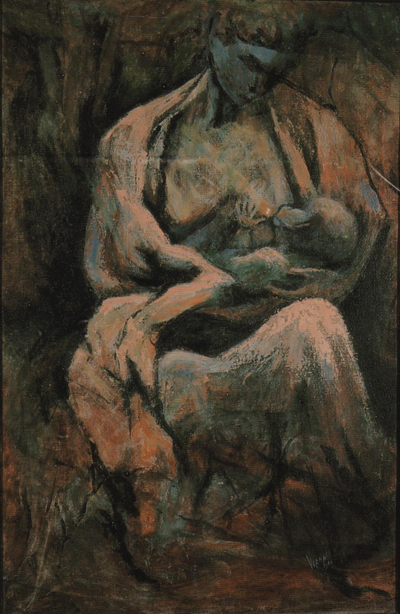 |
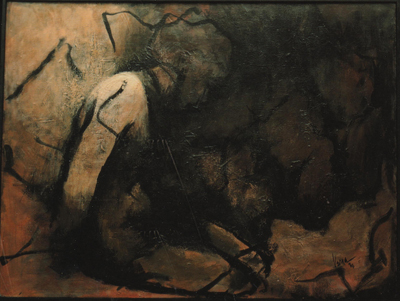 |
Widow
Brutally devastating experiences usually take awhile to set down in paint because the reaction to the memory is too overpowering to be able to do anything. Such was the case when my younger brother was killed by a speeding drunk driver just two days before Christmas in 1966. My deep grief made the expression of it futile. Nearly two years later, after many unsuccessful attempts, I was able to express not my OWN sense of loss but my feelings regarding the much greater loss felt by his young wife. One of my post-painting realizations was that in the background was the shadowy impression of three sad little figures--their children. The lighting behind and darkness ahead of the figure are explained in the write-up*:
My future's all behind me---
My love of life has fled.
He's closed his eyes forever---
My beloved man is dead.
What once was bright is darkness---
What once was joy is done.
My life spreads bleak before me
For all the years to come.
*The write up fell from the wall one day and cracked the glass---it seemed so appropriate to the mood that I have never replaced it. |
Footsteps on the Moon
In addition to sharing the worldwide joy and thrill of watching the first steps on th emoon, I was struck by the way their footprints reminded me of some of my collages using corrugated cardboard; so, I was off again---not trying to put anything down except the feeling of those footsteps, the crew and the world. At the time I worked up the accompanying poem:
The whole world watched and waited
As he slowly inched his way
To take that first momentous step
On a moon so far away.
His first words were impressive,
His "leap for all mankind,"
But then a joy came flooding through
The likes you rarely find.
For years of work--a promise kept,
And moments tense and long
Were ended momentarily
In happy feet and song.
As corrugated prints were left
In dust so strange and new,
Relief from tension swept the world
Who watched the dancing crew! |
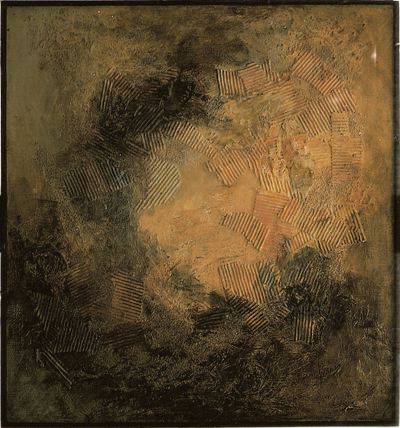 |
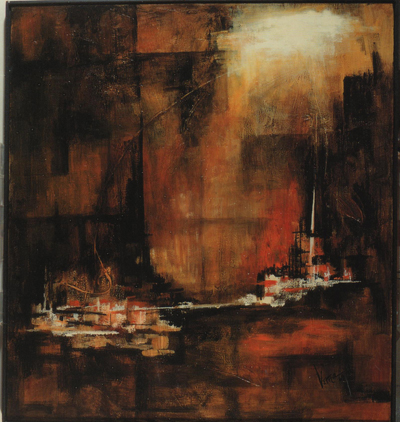 |
Apollospire
This painting began during the course of Apollo 9---with my mileage nearly as much as the Apollo's---dashing back and forth from the easel to the TV set to keep tabs on the flight and try to let it influence me. As is usual when I make up my mind to paint something specifically, I had a terrible time! . . . I'd think I was getting something and try to close in on it and immediately tighten up. I had to go through another period of hell punctuated with slashing strokes of gesso, give up and begin another abstract.
Once I relaxed and worked another week in the abstract, Apollospire soon appeared . ! . . the swoop and the dove are actually slashes of heavy gesso used in the destruction of my first attempt.
When I decided on a name, I wondered how people would pronounce it--would it be mispronounced to rhyme with spear? . . . . for the big difference between all the missles and the Apollo IS the difference between a spear and a spire---the same shape---but one pointed at one's fellowman, the other toward God . ! . !!
My writeup, hung with the painting, is as follows: |
What did you feel watching the flights of Apollo 8 and 9? . . .
A proud burst of patriotism . .
A sense of accomplishment . .
The joy of success . .
Of course! . . . but what MORE? . . .
An exhilerating enthusiasm . .
A feeling of hope for the world . .
A pride in the TRUE worth of Man . .
A spiritual uplift? . . . .
Why? . .
Because here, at least, ---(and at LAST!)---
Man has used that God-given quality---his Free-Will---
To devote his entire being: heart, mind and Soul
And to consecrate all his noblest traits---
(usually brought out strongest during war or tragedy)---
self-sacrifice
dedication
teamwork
heroism
Guts!
To an awe-inspiring PEACEFUL venture! . . .
And, in a dramatic moment of demonstrating
The unbelievable capacities of Man,
To proudly acknowledge
"And in the beginning, God" . ! . ! .
. . . . . . .
|
How does this painting portray the inspiration of the Apollo? . . .
To view a small town from a distance, one sees
The Church spire about all else. .
To view Apollo from a distance, one sees
the most stately spire of all
Towering as magnificent testimony
Of the faith of man in Man and in God ! !
And as it rises slowly and majestically from the pad toward Infinity,
There is a deep spiritual moving in the viewer.
And abstract Apollospire and gantry stand on the right in the painting
Bathed in warm oranges and sparkling whites . . .
Like the stained-glass effect of the gantry
Silhouetted against the rising sun . .
The bright area in the upper right expresses The Infinite.
To the right of the Apollo is a bird-form emerging from the darkness---
Yet with a dark shadow of himself to slip back into . . .
'Though brought a bit into light by the Apollo,
The peace dove has yet a long ways to go---
And could easily slip back into the blackness ! ! !
On the left is an abstract feeling of buildings representing the world of Man.
The swoop of orange above: the feelings of elation felt by the whole world!
. . . Like throwing a giant streamer into the skies at a very BIG ballgame! !
We MADE it ! ! ! Splashdown ! ! !
And this joy illumines at least one small segment
Of the yet dim arch of light connecting the world with THE Light ! . .
And in THIS beginning
Will MAN see the light and know that it is good,
And separate the light from the darkness ? . ! . |
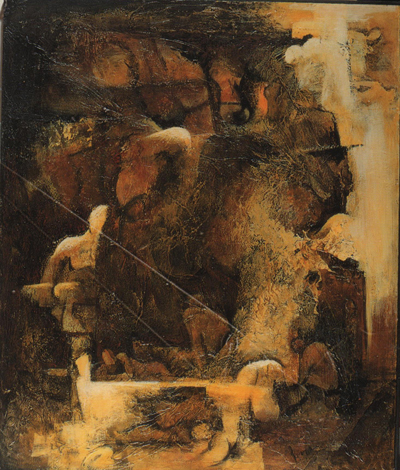 | People Power
During a period when my life was extremely hectic, upsetting and troubled, this painting was begun as an attempt at self-therapy in order to try to stabilize my badly frayed emotions so that I could continue to cope with the situations at hand.
Three days after my parents had come to visit us in May of 1970, my Mother fell and broke her hip. She was hospitalized and then found to have a heart condition which we had not known about...
[ed. During this time there were also other personal struggles with family members.]
...In the midst of all this...I had to do SOMETHING ! . . so, I began this painting . . . and people loomed everywhere. ! .
Looking at it now, I can see that even then I did have faith that SOMEHOW everything would straighten out. The troubles are expressed in an almost Rodin-ish "Gated of Hell" type painting with a sense of unknown forces blocking the way to happiness---yet, the light of faith is strong enough to overpower it all and come shining through . . . and my Mother did come safely through an operation to put a plate in her hip..and [ed my other people struggles worked themselves out.] |
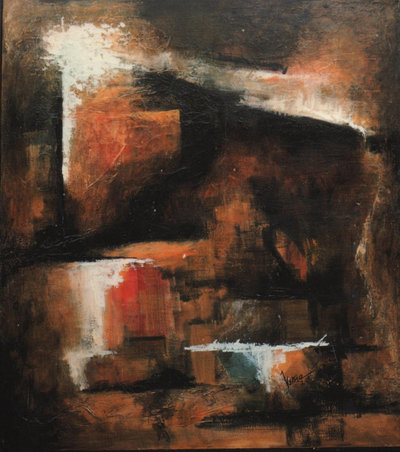 |
My Cup Runneth Over
Although chronologically not my latest work, I would like to end this book with "My Cup Runneth Over." This is, by far, the most personal painting I have as yet done and was begun before and completed after one of the most terrible experiences of my life. I was in one of my black moods of despair because the painting seemed at such a miserable stand still and I felt so drained of all creativity---with a forlorn "My God, why hast thou forsaken me" mood permeating my being. But the drama yet to unfold changed these depths of dismay to a surge of joy and gratitude and enabled me to finish the painting in an overflow of happiness. I can think of no better way to portray the meaning of the painting that to quote from the entry in one of my thought books: |
Entry on 2/17/69
Dear God! If ever in my life Your hand was evident, it was certainly during Valentine's night this year!
Just so that I will NEVER forget, I want to write down what we went through (all THREE of us---You, Hugh and me!) on that night. I was sleeping soundly when suddenly and instantaneously I was awakened by a cry of absolute terror from Hugh. The adrenalin poured into my system, my heart raced and I leaped out of bed the same instant he did. He kept crying out with sounds I shall never forget as long as I live! I knew somehow he was slipping from me! He ran from place to place in the room and I ran behind him not knowing WHAT it was except he kept holding his throat and thrashing up and down. I could not tell if the cries were from the excrutiating pain of a heart attack---and I knew HE couldn't tell me---he was fighting too hard to overcome whatever it was! And I knew I was helpless!
Somehow the thought to run for the phone and a doctor didn't even occur to me---because, I guess, I knew whatever was happening was going to be all over within a minute or two---and, suddenly, from the depths of my being, I uttered the most anguished, most fervent prayer of my whole life in just two words:
"Dear GOD! ! !
And YOU HEARD ME! ! . .
I didn't even have time to ASK You! . ! . ! . !
Just seconds that seemed an eternity after that cry on my part, which I am sure Hugh didn't hear because he was tearing my insides out with his own cries of terror--he seemed to relax and fell across the bed. That was the second when it seemed all eternity stood still. . was he dead? !!! . .and then I knew---well I didn't KNOW, really, but dared to HOPE---that he was going to be all right! . . he wasn't dead! ! !
Dear God, YOU saved my husband, handed him back to me---that I KNOW from the depths of my being ! . ! .
Hugh told me a bit about it afterward---that he has awakened because it seemed a bubble or food or something had come up into his throat and he tried to breathe some air into his lungs because they seemed empty and he couldn't! . . Whatever it was was blocking the flow of oxygen into his lungs---and he knew he had about 15 seconds to clear it---and he was powerless---nothing worked ! . . . he felt there was no way out because once he lost consciousness from lack of oxygen, he would never be able to clear the passage---he was staring DEATH right in the face! ! Somehow "I" knew he was, too---although I didn't know if it was a fatal heart attack or what ! .
If EVER there was proof of "Ask and you shall receive," THAT was the night! . . . without qualification I can say I NEVER uttered a greater plea to You! . . . I HAD to have YOU . . I was powerless! And You heard me! . . . You were there every second of that drama or how could You have known at that very instant what my whole being was begging of You? . ! .
Would You have let him slip from me if I had not acknowledged in every fibre of my being YOUR existence. . . YOUR power. . . MY need fo You? . ! . I will never know, but I DO know this: It has been the most profound experience of my life . ! . ! . . |
| |
|
| Book III ~ A New Testament |
Introduction
At the time that I completed Book II, I truly doubted that I could ever paint a "more personal" painting than "My Cup." When such thoughts entered my mind, I pondered and wondered . . . is there any point to going on? . . . what MORE can I do? . . . if I've painted the most personal painting I could ever paint, what else is left to paint? . ! . And then I remembered that, back in the days when I first "found the figure" in my Abstracts, I had the same sort of feelings---I had brought the figure back and still maintained the Abstract . . . the "impossible" according to McNeil . ! . . so what was there left to do? . ! . hadn't I "done everything"? . ! Yet the need to paint persists, and on I went, and soon what seemed an "end stage" of my development had shifted to a "beginning stage" of a new and better group of work.
Yet the last few years have been just about the most frustrating period I've ever spent---due in part to the trauma of a move and the readjustment to it, but also, I think, the result of "hang-over" feelings after "My Cup." Very few paintings satisfied me, and I painted and wiped-out and painted and wiped-out and re-painted ad infinitum---feeling driven to find something and yet feeling twarted in not being able to . ! . ! . .
So, deciding I needed a break in this "driving myself nutty" with frustration and also needed SOME feeling of accomplishment, I went back to school and realized another lifelong ambition . . . A BA in Fine Arts/studio major. ! . It proved a wise decision and was the catalyst in vaulting me out of my doldrums and into a new and exciting period of adventure. |
Whereas "My Cup" was a very personal painting due in great part to the life experience surrounding it, my new works are extremely personal in a different way. They are deeper explorations of my psyche oriented to the process of painting and the response to the paint itself. What seems paramount to me now is the act of painting rather than the resultant Art . . . in a sense, a type of "Process Art" wherein the "act of creation" is more important that "the thing created" . . . except I've not gone so far as to eliminate "the thing" . ! . .
What I AM doing is "letting myself go" with paint---more freely that I ever have before . . . letting "me" come out of the process of painting and its emotional effect on me. My previous works were attempts to put down an emotional experience . . . these paintings are more an attempt to "record" it---a striving to go deeper into how emotions not only "happen" but also are "communicated." The goal is a difficult one, and my wipe-outs will be many, but my paintings are becoming ever richer both in texture and in content because there's more of "me" in them . ! . ! .
Not all my paintings will be "happenings," of course, because there is so much to respond to in life, but those of "reaction" should become even more expressive than before as a result of my expanding ability to convey and express an emotion in paint. And if I can continue to probe ever deeper in the area of self-exploration, then the more penetrating should become the works expressing my responses to life itself. The future indeed holds a vast challenge . ! . ! . .
So, let's be on with it . . . |
The Four Elements
Life is made evident by growth and change---whether in Man or in Nature. That which does not change ceases living... or never lived at all. Painting, as a reflection of life, must do the same. Yet there are frustrating periods of limbo when one is on the brink of a growth period which seems so slow in coming! This painting followed such a period for me and was the break-through which put me in that particular state of being abstractly termed "Cloud Nine" . . extreme happiness.
There were at least three paintings underneath "The Four Elements," collage additions and wipe-outs, and the whole thing seemed a horrible "mess" when I began . . . almost as much a mess as the world seemed in, too, with all the "junk" going on: pollution, Watergate, oil crises, recession ! . ! But the "solution" to the painting seems, also, the only soluton to the world. |
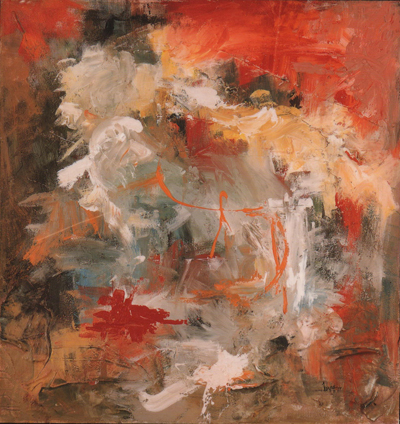 |
The reason "The Four Elements" is a break-through from my previous work is that "gut force" is what painted it ! . ! I didn't just go in and "color all the 'stuff' pretty"---I went in, had a major confrontation with the 'mess' and came out victorious . . It 'worked' . ! . ! . . .
And "coloring all the 'stuff' pretty" is not going to change the world either . ! . ! The only way out of the whole sordid state of affairs is for people (who are the ones who MADE the mess) to grapple head-on with the problems and, by gut force, make something decent out of the world again ! . .
Perhaps it seems a dichotomy of terms to call a painting about the mess the world is in "Cloud Nine" [ed. note: an earlier title for the painting] . . . but when the world, too, makes the break-through, we'll ALL be on Cloud Nine! . ! . ! . . |
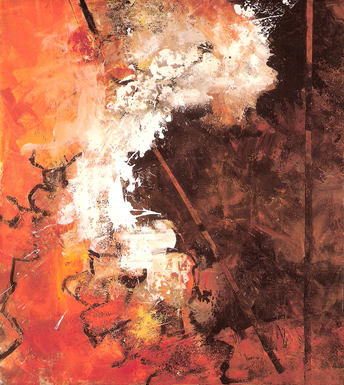 |
Capriccio
A fascinating realization struck me one day while flying over vast stretches of 'nothingness' in the middle West. . . the "imprint of Man" is the straight line ! . ! The earth is bascially undulating, flowing and lyrical in form; but I could tell immediately wherever man had been, for imprinted upon these 'organic' forms were his 'geometric' forms---streets, fields, towns, cities---all structured with the right angle and the straight line. !
Why does man do this? Is it a subconscious expression of an inner sense of the basic 'structure of things' . . . the basic geometry of the universe? Or is it his attempt to 'make order' out of the myriad of natural forms?
The latest collage additions are a reflection on these thoughts as well as a result of experiments with monoprints. My monoprints (a single print made by printing on glass, placing paper over it and printing) gained an additional dimension after I began 'structuring' the paint on the glass with strips of paper which left straight lines and geometric forms. |
When I felt my new acrylics were becoming overly lyrical because of the freer handling of the paint, I decided to try similar structuring in them. Capriccio is an example of "before" and "after" structuring . . . like "earth forces" and "man forces" . . .or is that becoming too 'lyrical' in a write-up? At any rate, I made a composition of strips and squares of canvas on the canvas BEFORE painting---feeling that this understructuring would maintain a solidity under the flow of paint. When I became dissatisfied with the original longer, rectangular shape, I took it off the stretchers, cut it down and re-stretched it onto its present squarer shape. Before I felt the canvas 'done,' the darker area needed 'something' and so I cut two strips from the cut-off area and collaged them onto the painting.
Capriccio is a musical term for a composition in a free, fanciful stye and seemed an appropriate title for a painting done in a happy mood of "free and fanciful" exploration. |
The Dancer [aka The Bluebird]
Sometimes the ability to "let loose" in paint comes easier than others. ! . This painting was completed on such an occasion. My methods of 'getting paint onto the canvas' were many and spontaneous, including transfer-printing of shapes I liked on the plastic film keeping my paints moist and heavy impastos using modeling paste. The 'free' mood I was in resulted in so much movement over the canvas that the collage understructure seems, almost the only thing keeping the paint from dancing right off into space . ! . . The emerging figure in the center has a feeling of twirling movement due to the oscillating nature of being able to interpret the "dancer" in two simultaneous stances.
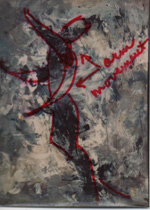
|
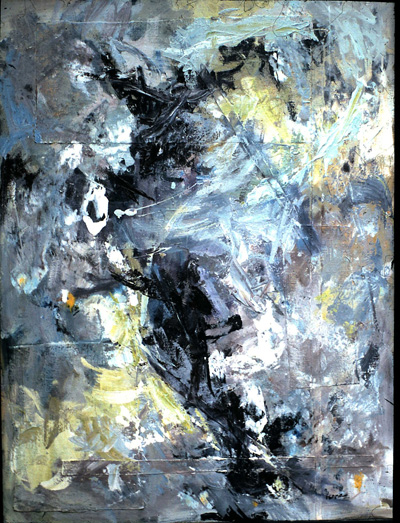 |
Mother Earth Revisited
Responses to nature still emerge from my superconscious, but there is a new sensation involved. Being able to crystallize my own movement in paint has seemed to enable me to capture, more than ever before, the feeling of movement in nature---the 'life force' at work. The image seems almost more 'actual' aht 'virtual' . ! . |
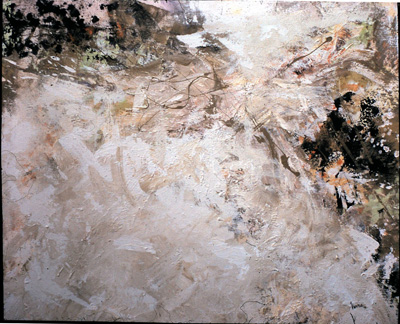
Frolicking Waters |
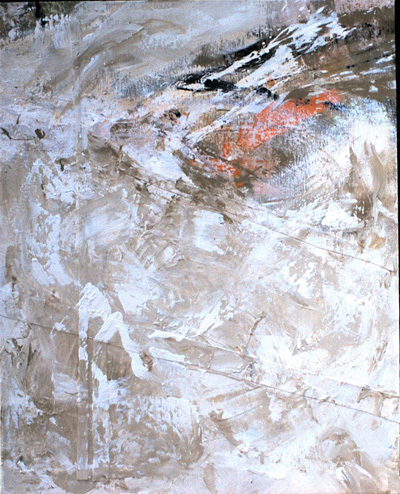
Whirlpool |
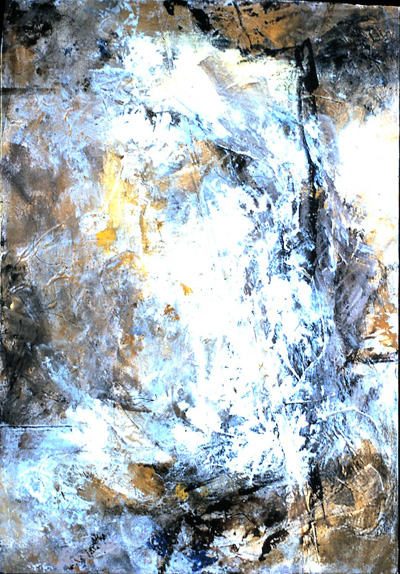
Nebulous Sunlight |
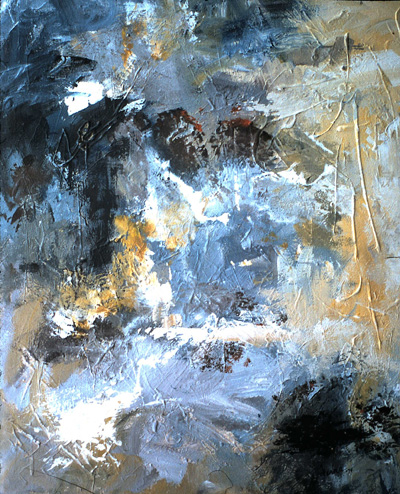
Sunshine Sonata |
Overture
Oftentimes my paintings still remain "unexplainable"---other than, perhaps, in the sense of music. This is such a painting and reflects my search for modes of expression of very deep sensation and feelings within me springing forth from depths still mainly unexplored.
And overture is an introduction to a developing musical composition, and my hope is that (as Prelude was before) this is only the BEGINNING of a development of better and more penetrating "depth probes." |
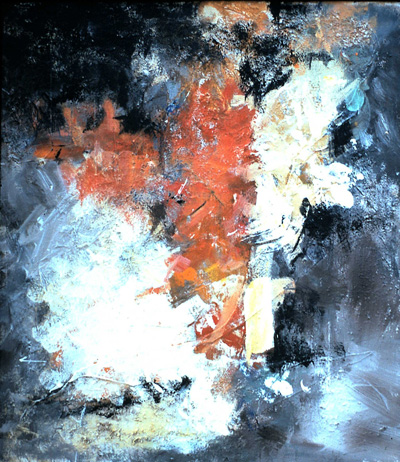 |
Experimentalism
Besides having an inherent NEED to write as well as to paint, I feel that writing affords me another avenue of self-penetration. In general, my write-ups (and always my titles) are done 'after the fact' . . . when I feel that the painting is 'done.' . .
How do I KNOW when a painting is done? . . It isn't easy! . If a painting 'seems' to be done, I will 'test it' to make sure by living with it awhile. I hang it and 'act like it's done.'
After a few hours, a day or two, or sometimes even longer, one of two things happens:
it continues to satisfy me . . .
or it isn't 'working' and I haul it down and go at it again. This can involve anything from slight changes to complete wipe-outs and always involves more 'trial hangings.'
Only when the painting goes beyond confronting me as a series of compositional problems to become an entity in itself capable of evoking an "Experience" in me do I know it's 'done,' ! . !
But at this point, my position changes to that of the spectator. And my attempts at write-ups are very similar to those who respond to the work. I have to probe again into the 'why . . . how did I 'feel' THEN and what was I 'responding to' . . . how do I feel and what am I responding to NOW? . . Until I can figure THAT out, I have difficulty in even titling the work. ! .
But, once I HAVE, there's an even richer sense of satisfaction and a feeling of 'expansion' from within like . . .
. . . a 'cup runneth over" . . .
[signed with love, Verna] |
| top |
back to books |
| home |
|
| |
|
|
